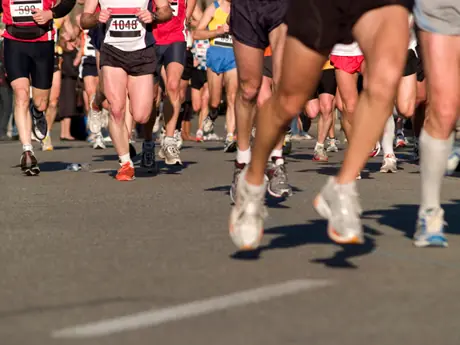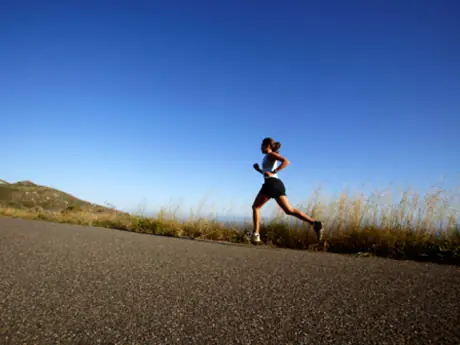Even the best runners in the world have a few tried and true rules they rely on to be successful. We caught up with Olympic gold medal winner Gwen Jorgensen at her home in Portland, Oregon, to learn how she sets herself up for success while training for the marathon and balancing her growing family.
1. Do your hard workouts in the morning.
“It’s interesting because when I was training for triathlon, if I did two runs in a day I would do an easy run in the morning and a hard run at night. But now I actually switch it up, so if I’m doing a hard run, it’s normally the first workout of the day.
It takes some adjusting to, but for the marathon—and really most running races—the races are in the morning. You’ve got to be able to get up and just get going right away, and kind of tap into that quickness right away on race morning.”
2. Build your mileage slowly.
“You have to not build up too quickly—really take your time building up to the mileage and pace you want to do. For me, when I first started running after giving birth to Stanley, my first run was a 1-minute run, 4-minute walk—just super slow, super easy getting back into it. I think that’s something that’s really important for everyone to do, and not just go right away, ‘alright if I want to run 80 miles a week, I’m going to go from zero last week to 80 this week.’ You can’t do it that way; you have to have a very slow progression. Even right now I’m not running twice a day every day because I’m just coming back from having a baby boy and I’m new to marathoning, so I’m slowly building up my mileage.”
3. Find a running buddy.
“I’m not big on listening to music while I run. I find it really motivational instead to run with other people. I think it holds you accountable because if you say to someone ‘you wanna go for a run?’, then you have to show up and you have to do it.
In Portland it is amazing because there are so many elite runners. I love training with people who are better than me because it holds me accountable, it makes me go faster on those days when maybe I’m not feeling it, it helps me push my limits and it also allows me to see what the world competition—the people I’m going to be racing against—what they’re doing. I’m able to know what I need to do to be successful on race day.”
4. Bring it back to technique.
“Sometimes in a race you’re super tired and you don’t know what to do. For me, I really like to bring it back to process-based things, technique-based things. If I’m really struggling—really hurting—I try to think about how I can adjust my form. For me a lot of times that’s relaxing my shoulders, letting my arms come through, thinking about a higher turnover or cadence. For example, maybe I’ll speed my arms up to make my legs go faster, and I really find that it distracts me from the pain but also makes me go faster.
The great thing about running is you can be a great runner and have different form from another great runner. Running is something you learn when you’re a kid, and it is very intuitive and everyone has different techniques or cues that may help them go faster. I think it is important to ask somebody that you’re running with or, if you have a coach, ask them for a technique adjustment you could make to help improve a little bit.”
5. Every run counts (yes, every).
“Make it easy on yourself. One of the things I love about running is you can do it anywhere, all you need is a pair of shoes. You can go from your front door; you don’t need to go to some special place to go for a run. Make it simplified. Even if you don’t have a lot of time, running is a great workout where you can just throw on some shoes, get out the door and immediately start your workout.
I get done, and I just feel like I’ve accomplished something. I go out there—it doesn’t matter if you’re out there for 15 minutes or 2 hours and 15 minutes—I get home and I feel like I accomplished something. I got the heart rate up, I got a good workout in and it just makes me feel good and allows me to enjoy the rest of the day.”
6. Never go out faster than you can maintain.
“On race day, you should never go out faster than you think you can maintain. The fastest way to get across the finish line is either to negative split (i.e. get faster) or to even split. So I think it is important to know how fast you can go and not exceed that at the beginning because you’ll really pay for it, and you’ll go a lot slower if you go too fast too quick.”
7. Find your personal motivation.
“The thing I really love about being a professional athlete is being able to relate to other people and get them motivated to get out the door. There’s one woman who I’ve been in contact with for quite a few years, and she said she just saw me on TV one day racing and decided she was going to get out there and be active. She had never run—never done anything—and now she’s done marathons, she’s done triathlons. That sort of thing really is inspiring and helps me feel like I’m helping other people as well.”
 READ THIS NEXT: A Day With: Gwen Jorgensen
READ THIS NEXT: A Day With: Gwen Jorgensen
About the Author

Get ACTIVE on the Go


Couch to 5K®
The best way to get new runners off the couch and across the finish line of their first 5K.
Available for iOS | Android







Discuss This Article